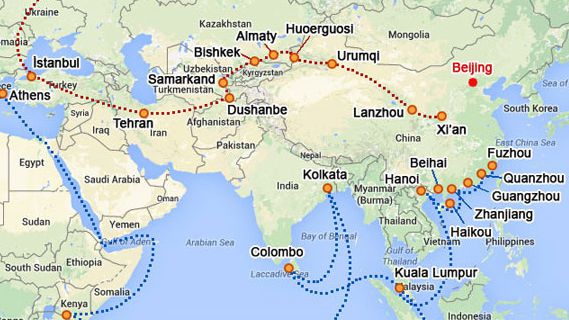0%

Belt and Road Initiative (BRI) is a massive infrastructure plan envisioned by China to build up a vast network of railways, highways, ports, pipelines, and communication spanning across the Eurasian continent inhabited by billions of people.
“Beijing will not shy away from world leadership and will even aim to promote its economic model around the globe,” Chinese President Xi Jinping had announced soon after becoming the general secretary of the Communist Party of China (CPC) in 2012.
China is investing approximately US $1.4 trillion in developing infrastructures including railways, highways, ports, pipelines, and communication under this single coordinated ‘Silk Road Initiative’ plan. The overland belt connects China with Central Asia, Russia, South Asia, and Europe and Russia.
China’s BRI plan can be viewed as a counter strategy to the Indo-Pacific Strategy put forth and pushed by the USA.
BRI includes six economic corridors that include China-Mongolia-Russia Corridor, New Eurasian Land Bridge, China-Central Asia-Western Asia Corridor, China-Pakistan Corridor, Indo-China Peninsula Corridor, and Bangladesh-China-India-Myanmar Corridor.
It aims at driving the economic development of developing and least developed countries along the roads of around 60 countries spanning across Eurasia.
Delivering his speech at the opening ceremony of BRI Forum for International Cooperation entitled “Work Together to Build the Silk Road Economic Belt and the 21st Century Maritime Silk Road” on May 14, 2017, in Beijing, President Xi had called BRI a “project of the century.”
Through its BRI, the country is trying to penetrate not only parts of Asia and Africa but also reach as far as Europe and America, becoming a major rival of the West. BRI, therefore, is a major theme of Chinese foreign policy devised to reach out to the world spreading its influence, trade, and culture.
Meanwhile, countries including some ASEAN members, United States, Japan, and India—appear divided over BRI. There are skepticism and suspicions surrounding BRI that China is putting developing and undeveloped countries under its debt trap. Though the positive impacts of economic growth upon the development of transportation infrastructure cannot be ruled out, the suspicion lies on the fact that a concerned developing country needs to bear the cost for the infrastructure within its territory. While China provides a loan to a country for infrastructure development, whether the country would rise to the capacity of clearing the debt is questionable.
For instance, Sri Lanka had to give Hambatota port on lease to China for its inability to pay back Chinese loan.
Similarly, Malaysian Prime Minister Mohammad Mahathir had canceled US $20 billion east-coast rail link under BRI, suspecting China’s intention to bring Malaysia under debt trap as reported by The Economist, a weekly magazine.
In early 2014, Sushil Koirala-led Nepal government had welcomed BRI and expressed the desire to work in close cooperation with China toward enhancing more connectivity and integration. It had signed a Memorandum of Understanding on Framework Agreement in Kathmandu, officially making it a part of the initiative in May 2017.
Even as BRI does not directly put Nepal under its six economic corridors, it mentions Nepal in the context of promoting the border trade, tourism, and cultural cooperation between Tibet and its neighboring countries such as Nepal.
Even though over 100 countries and international organizations have already supported BRI, time will tell us how the plans will go on. Nepal, the immediate neighbor of China, has to adopt a holistic approach to reap benefits from this initiative, while taking the geopolitical context into consideration.
(With inputs from agencies)